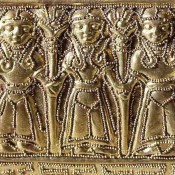Researchers can track cultural changes across ancient Africa by tracking the sizes of ostrich eggshell beads, according to a study published November 27, 2019 in the open-access journal PLOS ONE by Jennifer Miller of the Max Planck Institute for the Science of Human History and Elizabeth Sawchuk of Stony Brook University.
Beads made from ostrich eggshell are among the oldest known human-made ornaments, found at archaeological sites throughout Africa going back over 40,000 years. It has been recognized for many years that in southern African communities, these beads increased in size as the herding of domesticated animals was introduced, but this relationship has not been examined on other parts of the continent.
To explore whether bead size can inform broader cultural shifts, Miller and Sawchuk conducted a detailed analysis of bead sizes in southern and, for the first time, eastern Africa, and compared this data with evidence of other cultural changes. This analysis included data from 30 archaeological sites spanning the past 10,000 years of human history on the continent.
As expected, the authors found an increase in bead size in southern Africa associated with the introduction of sheep and goats around 2,000 years ago. These new bead proportions were likely introduced by the same foreign culture that brought herding practices to the region. In eastern Africa, however, the authors found consistently larger bead sizes over several thousand years, with no apparent correlation to herding. This suggests that cultural transmission of bead diameter is more complex than previously thought and that large bead size alone does not necessarily indicate herding. The authors recommend that future studies examine in more detail the manufacture and inter-regional transmission of these beads.
Miller adds: “Ostrich eggshell beads are small and tend to be overlooked in archaeological analysis, but they have the power to tell big stories about ancient human relationships. Today, we encounter economic change, cultural contact and immigration—people 5,000 years ago experienced these things too, and the beads give us a chance to understand how they dealt with it.”





